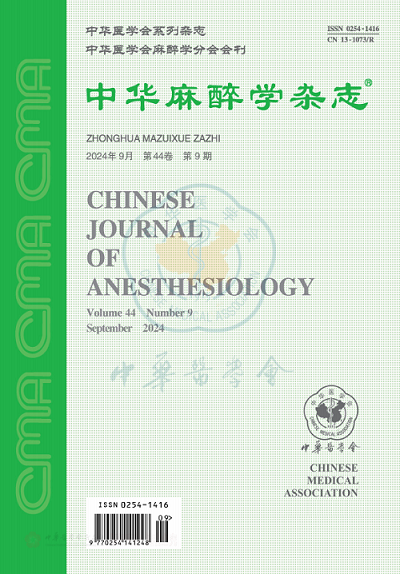Comparison of effect of total intravenous anesthesia with propofol and combined intravenous-inhalational anesthesia with sevoflurane on postoperative sleep quality in elderly female patients
Q4 Medicine
引用次数: 0
Abstract
Objective To compare the effect of total intravenous anesthesia with propofol and combined intravenous-inhalational anesthesia with sevoflurane on postoperative sleep quality in elderly female patients. Methods One hundred and twenty patients, aged 65-80 yr, with body mass index of 18.5-25.0 kg/m2, of American Society of Anesthesiologists physical status Ⅰ-Ⅲ, scheduled for elective gynecological laparoscopic operation, were divided into 2 groups (n=60 each) by a random number table method: total intravenous anesthesia with propofol group (group P) and combined intravenous-inhalational anesthesia with sevoflurane group (group S). Anesthesia was induced with intravenous etomidate 0.2-0.3mg/kg, sufentanil 0.2-0.4 μg/kg and cisatracurium 0.10-0.15 mg/kg.Anesthesia was maintained as follows: propofol was given by target-controlled infusion with the target plasma concentration set at 2-4 μg/ml in group P, 1.2-2.3% sevoflurane was inhaled in group S, and sufentanil 0.2-0.3 μg/kg and cisatracurium 0.04-0.06 mg/kg were intermittently injected in two groups.The patients were followed up at 7-8 a. m.on the day of hospitalization, the day of operation and 1, 3, 7 and 30 days after operation.The Pittsburgh Sleep Quality Index (PSQI) was recorded, PSQI > 7 points was considered as sleep disorders, and the occurrence of sleep disorders was recorded.The morning urine was collected at the time points mentioned above, and the concentrations of melatonin sulfate and free cortisol were determined by enzyme-linked immunosorbent assay. Results Compared with group S, the PSQI was significantly decreased on 3 and 7 days after operation, the incidence of sleep disorder was decreased on 7 days after operation, the concentrations of melatonin sulfate in urine were increased (P 0.05). Conclusion The effect of total intravenous anesthesia with propofol on postoperative sleep quality is less than that of combined intravenous-inhalational anesthesia with sevoflurane in elderly female patients. Key words: Propofol; Anesthetics, inhalation; Anesthesia, general; Aged; Femininity; Sleep quality异丙酚静脉全麻与七氟醚静脉吸入复合麻醉对老年女性患者术后睡眠质量的影响比较
目的比较异丙酚静脉全麻与七氟醚静脉吸入复合麻醉对老年女性患者术后睡眠质量的影响。方法采用随机数字表法将120例年龄65 ~ 80岁,体质指数18.5 ~ 25.0 kg/m2,符合美国麻醉医师协会体质状况Ⅰ~Ⅲ的择期妇科腹腔镜手术患者分为两组,每组60例。丙泊酚全静脉麻醉组(P组)和七氟醚静脉吸入联合麻醉组(S组),麻醉诱导剂分别为依托咪酯0.2 ~ 0.3mg/kg、舒芬太尼0.2 ~ 0.4 μg/kg、顺阿曲库铵0.10 ~ 0.15 mg/kg。麻醉维持如下:P组靶控输注异丙酚,靶血药浓度2 ~ 4 μg/ml, S组吸入1.2 ~ 2.3%七氟醚,两组间歇注射舒芬太尼0.2 ~ 0.3 μg/kg,顺阿曲库铵0.04 ~ 0.06 mg/kg。分别于住院当日、手术当日及术后第1、3、7、30天上午7 ~ 8时进行随访。记录匹兹堡睡眠质量指数(PSQI), PSQI bb0.7分为睡眠障碍,记录睡眠障碍的发生情况。在上述时间点采集晨尿,采用酶联免疫吸附法测定硫酸褪黑激素和游离皮质醇的浓度。结果与S组比较,术后3 d、7 d PSQI明显降低,术后7 d睡眠障碍发生率降低,尿中硫酸褪黑素浓度升高(P < 0.05)。结论异丙酚全静脉麻醉对老年女性患者术后睡眠质量的影响小于七氟醚静脉吸入联合麻醉。关键词:异丙酚;吸入麻醉药;麻醉,一般;岁的;女性气质;睡眠质量
本文章由计算机程序翻译,如有差异,请以英文原文为准。
求助全文
约1分钟内获得全文
求助全文

 求助内容:
求助内容: 应助结果提醒方式:
应助结果提醒方式:


